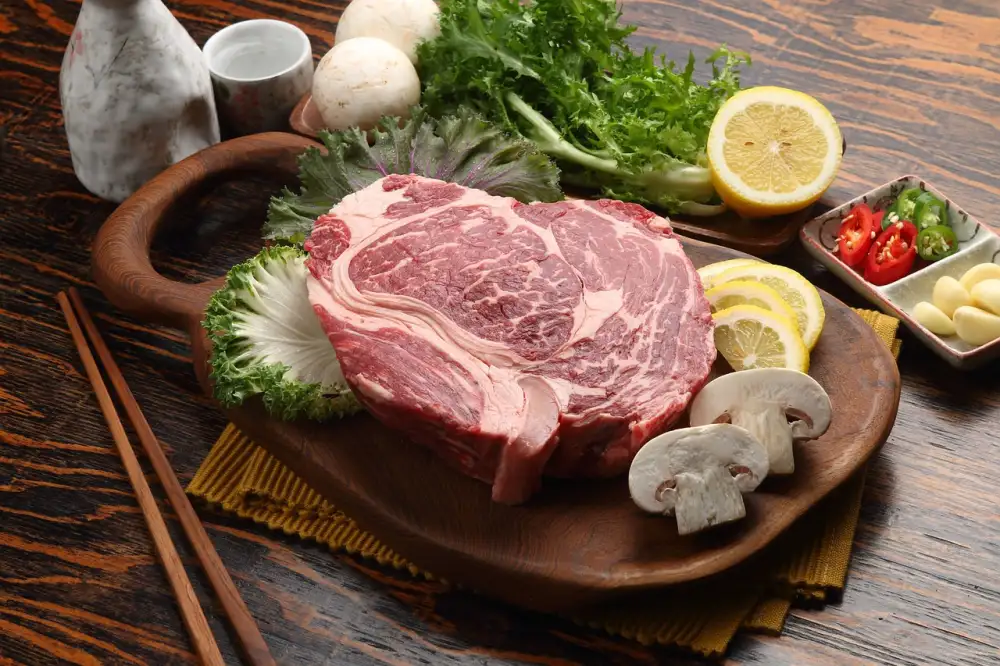Exploring the Savory Delights of Korean Beef: Recipes and Insights

- History and Cultural Significance of Korean Beef
- Types of Korean Beef Cuts and Grades
- Traditional Korean Beef Recipes
- Bulgogi: Marinated Korean Beef
- Galbi: Grilled Korean Beef Short Ribs
- Yukhoe: Korean Beef Tartare
- Modern Korean Beef Fusion Recipes
- Korean Beef Tacos
- Korean Beef Bibimbap
- Korean Beef Stir-Fry
- Health Benefits of Korean Beef
- Tips for Cooking Korean Beef at Home
- Where to Find and Buy Korean Beef
Korean beef, also known as Hanwoo, is a culinary delight that has captivated food enthusiasts around the world. Renowned for its exceptional tenderness and rich flavor, Korean beef offers a unique dining experience that is sure to tantalize your taste buds. Whether you prefer it marinated, grilled, or served raw, Korean beef promises an explosion of savory goodness in every bite. In this article, we will delve into the history and cultural significance of Korean beef, explore traditional and modern recipes, discuss its health benefits, and provide tips on how to cook it at home. So get ready to embark on a journey through the savory delights of Korean beef!
History and Cultural Significance of Korean Beef
Korean beef, also known as Hanwoo, holds a rich history and cultural significance in Korea. Dating back to ancient times, beef was considered a luxury food reserved for the upper class. It wasn't until the 19th century that beef consumption became more widespread among the general population.
During the Joseon Dynasty, cattle were primarily used for farming and transportation purposes. However, with the introduction of Western influences in the late 19th century, Koreans began to appreciate the taste and nutritional value of beef.
Today, Korean beef is highly regarded for its exceptional quality and flavor. The breed of cattle used for Korean beef is raised under strict regulations to ensure premium meat. These cattle are fed a special diet consisting of organic grains and grasses, resulting in tender and marbled meat.
Korean beef has become an integral part of Korean cuisine and is commonly enjoyed during special occasions such as holidays and celebrations. It is often featured in traditional dishes like bulgogi (marinated beef), galbi (grilled short ribs), and yukhoe (beef tartare).
The cultural significance of Korean beef extends beyond its culinary appeal. It represents prosperity, wealth, and abundance in Korean society. Sharing a meal that includes Korean beef is seen as a symbol of hospitality and generosity.
With its deep-rooted history and cultural significance, Korean beef continues to captivate food enthusiasts around the world. Its unique flavors and textures make it a truly remarkable ingredient that showcases the culinary excellence of Korea.
Types of Korean Beef Cuts and Grades
Korean beef is known for its high quality and diverse cuts. The most popular cuts include bulgogi, which is thinly sliced ribeye or sirloin; galbi, which are beef short ribs; and yukhoe, which is raw beef tartare. Each cut offers a unique texture and flavor profile, making Korean beef a versatile ingredient in various dishes. Additionally, Korean beef is graded based on its marbling and tenderness, with higher grades indicating superior quality. These different cuts and grades allow for a wide range of culinary possibilities when it comes to cooking with Korean beef.
Traditional Korean Beef Recipes
Korean cuisine is known for its bold flavors and unique cooking techniques, and Korean beef dishes are no exception. Here are three traditional Korean beef recipes that showcase the rich and savory delights of this beloved ingredient.
1. Bulgogi: Marinated Korean Beef
Bulgogi is a classic Korean dish made with thinly sliced beef marinated in a mixture of soy sauce, garlic, sugar, sesame oil, and other seasonings. The meat is then grilled or stir-fried until tender and caramelized. The result is a mouthwatering combination of sweet, savory, and smoky flavors that pairs perfectly with steamed rice and side dishes.
2. Galbi: Grilled Korean Beef Short Ribs
Galbi, or grilled beef short ribs, is another popular Korean dish that is loved for its tender meat and delicious marinade. The ribs are typically marinated in a mixture of soy sauce, garlic, ginger, sugar, sesame oil, and pear juice to add sweetness and help tenderize the meat. They are then grilled to perfection, resulting in juicy and flavorful ribs that are often enjoyed with lettuce wraps or steamed rice.
3. Yukhoe: Korean Beef Tartare
Yukhoe is a unique Korean dish that showcases the quality of the beef by serving it raw as tartare. The beef is finely minced or thinly sliced and mixed with soy sauce, sesame oil, garlic, sugar, green onions, and other seasonings. It is often topped with a raw egg yolk for added richness. This elegant dish offers a delicate balance of textures and flavors that will delight any adventurous food lover.
These traditional Korean beef recipes highlight the versatility of this ingredient while staying true to its cultural roots. Whether you prefer the bold flavors of bulgogi or the tender succulence of galbi, these dishes will surely satisfy your cravings for authentic Korean cuisine.
Bulgogi: Marinated Korean Beef
Bulgogi, one of the most popular Korean beef dishes, is a savory and flavorful delight that showcases the unique culinary traditions of Korea. The word "bulgogi" translates to "fire meat," which refers to the traditional method of grilling the marinated beef over an open flame.
The key to making delicious bulgogi lies in the marinade. It typically consists of soy sauce, sesame oil, garlic, ginger, sugar, and pear juice. The combination of these ingredients creates a perfect balance of sweet and savory flavors that infuse into the thinly sliced beef.
To prepare bulgogi, start by slicing your choice of beef (common cuts include sirloin or ribeye) into thin strips. Then, mix the marinade ingredients together and let the beef soak in it for at least 30 minutes or overnight for maximum flavor.
Once marinated, you can cook bulgogi on a grill pan or stovetop over high heat. The goal is to achieve a slightly charred exterior while keeping the inside tender and juicy. As you cook the beef, you'll notice its enticing aroma filling your kitchen.
Traditionally, bulgogi is served with rice and a variety of side dishes such as kimchi and pickled vegetables. However, you can also enjoy it in lettuce wraps or as a filling for Korean-style tacos.
Whether you're hosting a dinner party or simply craving a taste of Korean cuisine at home, bulgogi is sure to impress with its rich flavors and tender texture. Give this classic Korean dish a try and experience the mouthwatering delights it has to offer.
Galbi: Grilled Korean Beef Short Ribs
Galbi, also known as grilled Korean beef short ribs, is a popular dish that showcases the rich flavors of Korean beef. The tender and succulent meat is marinated in a mixture of soy sauce, garlic, ginger, sugar, and sesame oil to create a delightful combination of sweet and savory flavors. The marinade helps to tenderize the meat and infuse it with delicious aromas.
Traditionally, galbi is prepared by grilling the marinated short ribs over an open flame or charcoal grill. This cooking method imparts a smoky flavor to the meat and creates a caramelized crust on the outside while keeping the inside juicy and flavorful. The result is a mouthwatering dish that is both visually appealing and incredibly tasty.
Galbi is often enjoyed with a variety of side dishes such as kimchi, pickled vegetables, and steamed rice. The combination of flavors and textures makes for a satisfying meal that is deeply rooted in Korean culinary traditions.
Whether you're grilling galbi at home or enjoying it at a Korean restaurant, this classic dish is sure to impress your taste buds with its bold flavors and tender texture. So next time you're craving something deliciously savory, give galbi a try and experience the incredible taste of Korean beef.
Yukhoe: Korean Beef Tartare
Yukhoe is a traditional Korean dish that showcases the delicate flavors of raw beef. Similar to steak tartare, yukhoe is made with finely minced beef, typically from the tenderloin or sirloin cuts. The beef is seasoned with soy sauce, sesame oil, garlic, and other aromatic ingredients to enhance its natural taste.
The dish is often served with a raw egg yolk on top, which adds richness and creaminess to the meat. It is also garnished with thinly sliced pear or cucumber for a refreshing crunch. The combination of flavors and textures in yukhoe creates a unique dining experience.
Yukhoe is not only delicious but also offers several health benefits. Beef is an excellent source of protein, iron, and essential amino acids. Additionally, the dish contains healthy fats from sesame oil and vitamins from fresh vegetables. However, it's important to use high-quality beef from trusted sources when preparing raw dishes like yukhoe.
To make yukhoe at home, start by freezing the beef for a short period to ensure safety. Then, finely mince the meat and mix it with the seasonings until well combined. Serve immediately with your choice of garnishes and enjoy this exquisite Korean delicacy.
Whether you're a fan of raw dishes or looking to explore new culinary experiences, yukhoe is definitely worth trying. Its unique blend of flavors and textures will tantalize your taste buds and introduce you to the rich gastronomic heritage of Korea.
Modern Korean Beef Fusion Recipes
a. Korean Beef Tacos: Combine the bold flavors of Korean beef with the popular Mexican dish. Fill warm tortillas with tender marinated beef, crisp vegetables, and a drizzle of spicy gochujang sauce for a delicious fusion experience.
b. Korean Beef Bibimbap: Create a vibrant and nutritious bowl by topping steamed rice with sautéed vegetables, thinly sliced Korean beef, and a fried egg. Drizzle with sesame oil and gochujang sauce for an explosion of flavors.
c. Korean Beef Stir-Fry: Put a twist on the classic stir-fry by using thinly sliced Korean beef as the star ingredient. Sauté it with colorful vegetables and a savory soy-based sauce for a quick and satisfying meal that bursts with Korean-inspired taste sensations.
These modern fusion recipes showcase the versatility of Korean beef, allowing you to explore new culinary horizons while still savoring its rich flavors.
Korean Beef Tacos
Korean Beef Tacos are a delicious fusion of Korean and Mexican flavors. This modern twist on a classic dish combines tender, marinated Korean beef with the fresh crunch of taco toppings. The beef is typically marinated in a mixture of soy sauce, garlic, ginger, and sesame oil, which infuses it with rich umami flavors. Once cooked to perfection, the beef is placed in warm tortillas and topped with tangy kimchi, crisp lettuce, and spicy gochujang sauce. The combination of savory, sweet, and spicy flavors creates a mouthwatering experience that will leave you craving more. Whether you're hosting a dinner party or looking for a quick weeknight meal, Korean Beef Tacos are sure to impress your taste buds and add some excitement to your culinary repertoire.
Korean Beef Bibimbap
Korean Beef Bibimbap is a popular and vibrant dish that showcases the flavors and textures of Korean beef. This colorful and nutritious meal consists of a bed of steamed rice topped with sautéed vegetables, thinly sliced marinated beef, a fried egg, and a dollop of spicy gochujang sauce. The beef is typically marinated in a mixture of soy sauce, sesame oil, garlic, and sugar to enhance its flavor. The combination of tender beef, crispy vegetables, and the runny yolk from the fried egg creates a delightful medley of tastes and textures. Bibimbap is not only delicious but also highly nutritious as it provides a balanced mix of protein, carbohydrates, vitamins, and minerals. This versatile dish can be customized to suit individual preferences by adding or omitting certain ingredients. Whether enjoyed at home or in a Korean restaurant, Korean Beef Bibimbap is sure to satisfy both your taste buds and your appetite.
Korean Beef Stir-Fry
Korean Beef Stir-Fry is a popular and delicious dish that showcases the bold flavors of Korean cuisine. This quick and easy recipe combines thinly sliced beef with an assortment of colorful vegetables, all cooked together in a savory sauce. The key to a successful stir-fry lies in the perfect balance of flavors and textures. The tender beef, crisp vegetables, and umami-rich sauce create a harmonious blend that is both satisfying and flavorful. With just a few simple ingredients and some basic cooking techniques, you can recreate this classic Korean dish in your own kitchen. So grab your wok or skillet, gather your ingredients, and get ready to enjoy the tantalizing taste of Korean Beef Stir-Fry!
Health Benefits of Korean Beef
Korean beef not only tantalizes the taste buds but also offers a range of health benefits. Firstly, it is a rich source of high-quality protein, essential for muscle growth and repair. Additionally, Korean beef contains important vitamins and minerals such as iron, zinc, and vitamin B12, which are crucial for maintaining a healthy immune system and promoting optimal brain function.
Moreover, Korean beef is known for its low fat content compared to other types of beef. This makes it a healthier choice for those watching their cholesterol levels or trying to maintain a balanced diet. The marbling in Korean beef provides a natural tenderness and juiciness without excessive fat.
Furthermore, Korean beef is often grass-fed, which means it contains higher levels of omega-3 fatty acids and conjugated linoleic acid (CLA). These compounds have been linked to various health benefits including reduced inflammation, improved heart health, and even potential cancer-fighting properties.
In summary, indulging in the savory delights of Korean beef not only satisfies your taste buds but also provides you with valuable nutrients and health advantages. So go ahead and savor the flavors while reaping the benefits!
Tips for Cooking Korean Beef at Home
1. Marinate for Flavor: To infuse your Korean beef with maximum flavor, marinate it for at least 30 minutes or overnight. Use a mixture of soy sauce, garlic, ginger, sesame oil, and sugar for a traditional taste.
2. Preheat the Grill: If you're grilling Korean beef, make sure to preheat your grill to high heat. This will help sear the meat quickly and lock in the juices.
3. Proper Slicing: When slicing Korean beef for dishes like bulgogi or stir-fry, it's important to cut against the grain. This ensures that the meat remains tender and easy to chew.
4. Don't Overcook: Korean beef is best enjoyed when cooked to medium-rare or medium doneness. Overcooking can result in tough and dry meat.
5. Use High Heat: Whether you're stir-frying or grilling, using high heat is crucial for achieving that signature caramelization and char on your Korean beef.
6. Garnish with Sesame Seeds: Adding toasted sesame seeds as a garnish not only adds a nutty flavor but also provides a pleasant crunch to your dish.
7. Serve with Banchan: Traditional Korean side dishes known as banchan complement the flavors of Korean beef perfectly. Consider serving kimchi, pickled vegetables, or steamed rice alongside your main dish.
By following these tips, you can recreate the delicious flavors of Korean beef right in your own kitchen!
Where to Find and Buy Korean Beef
Korean beef can be found in various places, both online and offline. If you're looking for a wide selection and convenience, online platforms like Korean grocery stores or specialized websites are your best bet. These platforms offer a range of cuts and grades, allowing you to choose according to your preferences.
For those who prefer the traditional experience, local Korean markets or butcher shops are great options. Here, you can interact with knowledgeable staff who can guide you through the different cuts and help you select the best quality beef.
If you're lucky enough to live near a Korean restaurant or barbecue joint, they may also sell fresh or marinated Korean beef for takeout. This not only gives you the opportunity to try authentic dishes but also allows you to bring home some high-quality meat.
When buying Korean beef, it's important to look for reputable sources that prioritize quality and ethical practices. Check for certifications such as USDA grading or organic labels if those factors are important to you.
Whether online or offline, exploring different sources will give you a better understanding of the options available and help you find the best place to buy delicious Korean beef for your culinary adventures.
In conclusion, Korean beef offers a tantalizing and diverse range of flavors that have captivated food enthusiasts around the world. From traditional recipes like bulgogi and galbi to modern fusion dishes like Korean beef tacos and bibimbap, there is something for everyone to enjoy.
Not only does Korean beef provide a delicious culinary experience, but it also holds cultural significance and a rich history. The different cuts and grades of Korean beef allow for versatility in cooking, ensuring that each dish is tender and flavorful.
Furthermore, Korean beef offers numerous health benefits, being a great source of protein, vitamins, and minerals. Its lean nature makes it a healthy choice for those looking to maintain a balanced diet.
Whether you're a seasoned chef or an amateur cook, exploring the savory delights of Korean beef can be an exciting culinary adventure. With these insights into traditional recipes, modern fusion dishes, tips for cooking at home, and where to find and buy Korean beef, you'll be well-equipped to embark on your own journey into the world of this delectable cuisine.
So why wait? Start exploring the rich flavors of Korean beef today and elevate your dining experience with its unique taste and cultural significance.
Published: 06. 12. 2023
Category: Food



